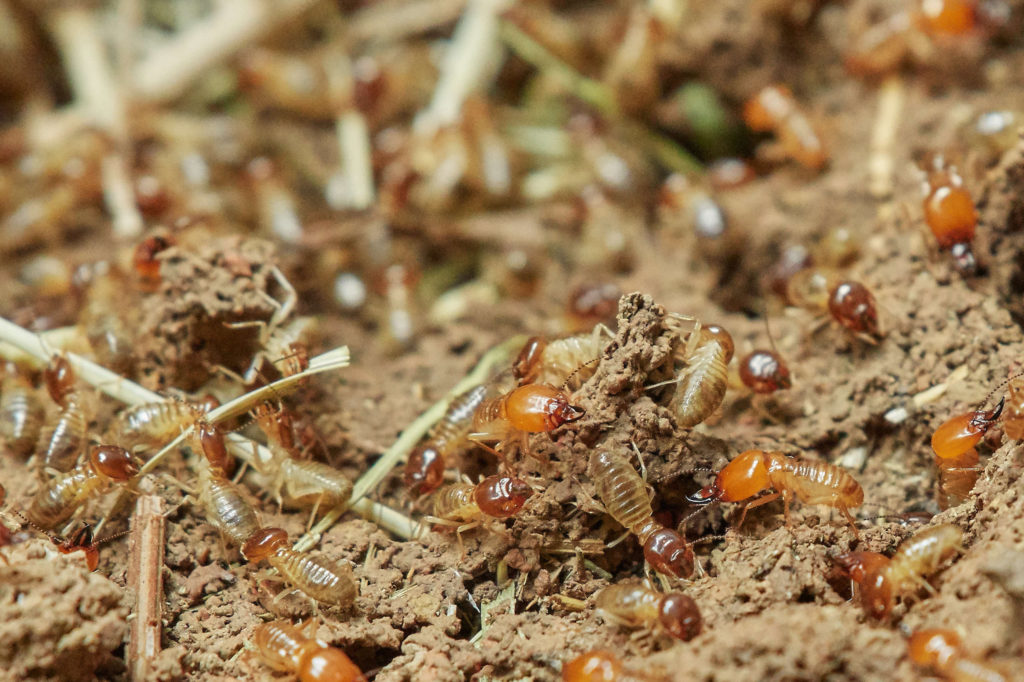Termites

Termites (commonly known as white ants) are one of the most destructive pests in Australia. They cause millions of dollars of damage to homes and structures throughout Melbourne and Victoria every year. According to CSIRO 1 in 3 homes will be affected by termites within the economic life of the structure. Termites are found in Melbourne and throughout all of Victoria, all too often, the presence of these home invaders goes undetected until damage is discovered by chance. This damage is not covered by most insurance companies.
Do you think you have Termites?
If you think you have termites or you have found a suspect skirting board or door frame it is very important not to disturb or break open the damaged timber or workings as the termites will shut down the disturbed area and possibly begin damaging elsewhere in your home.
How do you tell if you have termites
Termites eat timber, hollowing it out from the inside this can cause the timber to appear like it is bubbling or wrinkled. Sometimes the termites eat through and will patch the hole up with mud. Inside a home most people find termites in flooring, skirting boards and door frames.
If your flooring feels soft underfoot or your vacuum cleaning goes through the skirting board, the first thing to do is call us now and arrange one of our accredited professional termite inspectors to carry out an inspection.
Do you have termites in or around your home?
Here are some signs:
- Damaged timber: A hollowed-out piece of timber that has been damaged by termites usually sounds hollow.
- Usually from mid-October till early March established nests disperse young reproductive, winged termites out to start new colonies. On a warm and humid evening, hundreds of them will leave the nest at once, so their numbers look like swarms of flying ants. If you spot alates around your home, this could be a sign of termite infestation.
- Termite leads: Termites are fragile insects. They don’t have many defences against predators and require a moist and humid environment to survive. To get around safely when they are not underground or inside a piece of timber, they build leads, small tunnels made of mud and cellulose. The tubes look like little brown straws.
Termite Prevention Tips
As a homeowner, there are steps you can take to discourage and even prevent termites in your home! Follow these termite prevention tips.
- We recommend removing all loose timbers stored in contact with the ground in the subfloor and around the exterior of the home as they are conducive to termite activity.
- We recommend removing and/or replace landscaping timbers and timber retaining walls with a non-susceptible material, as it is conducive to termite attack.
- We recommend keeping garden beds below the weep holes and/or vents in the external walls as it allows concealed termite entry.
- We recommend you ensure that your vents are clear to allow cross-flow ventilation under the home as poor ventilation creates conducive conditions for termite attack.
- Timbers in ground contact can provide concealed access for termite activity, we recommend for the timber to either be removed or for the timbers to be raised on metal stirrups.
- Termites are attracted to moisture, so fix any leaking water pipes, drains, showers, and sinks as soon as possible.
- If you have a water tank we recommend for the water tank overflow to be plumbed to stormwater as excessive moisture promotes termite attack
- Most hot water services have a relief valve and normally this drains against the home, we recommend for the hot water service overflow to be plumbed to a drain or away from the home as excessive moisture promotes termite attack
- Regular termite inspections by an experienced and accredited termite inspector are recommended. An inspection of the property should be carried out every 6-12 months. Regular inspections don’t stop termite attack but they limit the amount of damage caused before being detected.